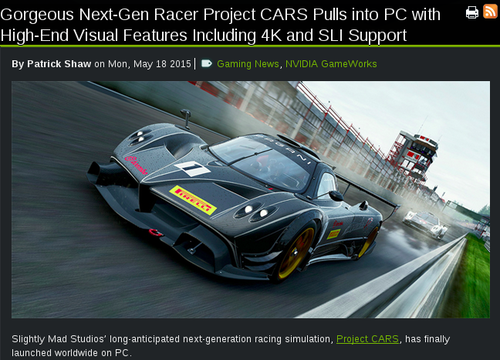Lo studio di Project CARS, dopo aver ricevuto una valanga di critiche da parte di utenti, sia AMD sia NVIDIA, inferociti per le mediocri prestazioni garantite dalle schede video dotate di GPU GCN e Kepler, ha voluto chiarire la situazione con il seguente comunicato, che riportiamo interamente.
In particolare, gli Slightly Mad Studios hanno precisato che ProjectCARS non è un titolo GameWorks, e che NVIDIA non ha sponsorizzato lo studio. Sinceramente, non conoscendo i termini di contratto tra le due case relativi alla collaborazione che è intercorsa, non possiamo affermare se quanto riportato nel comunicato è vero o falso, ma si tratta comunque di un'affermazione coraggiosa. Perché coraggiosa? Perché l'utenza si è andata a spulciare il sito NVIDIA e le comunicazioni passate, ed alcune cose interessanti sono saltate fuori.
In order to correct the wrongful assumptions regarding Project CARS’ performance on AMD GPUs, the MADNESS engine and the degree of involvement from our third-party technical partners, Slightly Mad Studios pointed out the following facts:
• Project CARS is not a GameWorks product. We have a good working relationship with nVidia, as we do with AMD, but we have our own render technology which covers everything we need.
• NVidia are not “sponsors” of the project. The company has not received, and would not expect, financial assistance from third party hardware companies.
• The MADNESS engine runs PhysX at only 50Hz and not at 600Hz as mentioned in several articles
• The MADNESS engine uses PhysX for collision detection and dynamic objects, which is a small part of the overall physics systems
• The MADNESS engine does not use PhysX for the SETA tyre model or for the chassis constraint solver (our two most expensive physics sub-systems)
• The MADNESS engine does not use PhysX for the AI systems or for raycasting, we use a bespoke optimised solution for those
• The physics systems run completely independently of the rendering and main game threads and utilises 2 cores at 600Hz
• The physics threading does not interact with the rendering, it is a push system sending updated positional information to the render bridge at 600Hz
• Any performance difference with PhysX would not be reflected with differences in comparing rendering frame rates. There is no interaction between PhysX and the rendering
• Overall, PhysX uses less than 10% of all physics thread CPU on PC. It is a very small part of the physics system so would not make a visual difference if run on the CPU or GPU
• Direct involvement with both nVidia and AMD has been fruitful in assisting with the game performance at various stages of development. Both AMD and nVidia have had access to working builds of the game throughout development, and they have both tested builds and reported their results and offered suggestions for performance improvements.
• Testing of the game with different driver versions has produced a variety of performance results on both nVidia and AMD hardware. This is entirely to be expected as driver changes cannot always be tested on every game and every card, and this is the reason why both companies produce game-specific driver profiles, to ensure that they can get the best out of the game.
• Project CARS does not use nVidia specific particle technology – the system we use is a modified version of the same technology we used on the Need for Speed : Shift and Shift Unleashed games, and was entirely developed in-house. The reason the performance drops when there are a lot of particles on screen is simply because processing a large number of particles is very expensive.
Prima di tutto, sul sito NVIDIA il titolo in questione è classificato come facente parte del programma GameWorks (vedesi screen e link uno e due).
Secondariamente, i comunicati stampa di NVIDIA destinati alle riviste classificano Project CARS come gioco GameWorks. Qui, ad esempio, la news di AnandTech a riguardo (non certo un portale gestito da incapaci ...).
Nel gioco, poi, possiamo osservare come il logo NVIDIA sia spesso ben in vista.
In ultimo, questo video mostra come Project CARS sia un gioco facente parte del programma The Way It's Meant to be Played, quindi in qualche modo deve essere stato finanziato dalla casa in verde.
I videogiocatori si sono già divisi in due schieramenti, quelli che supportano gli SMS e chi invece rimane scettico. Voi da che parte state?



